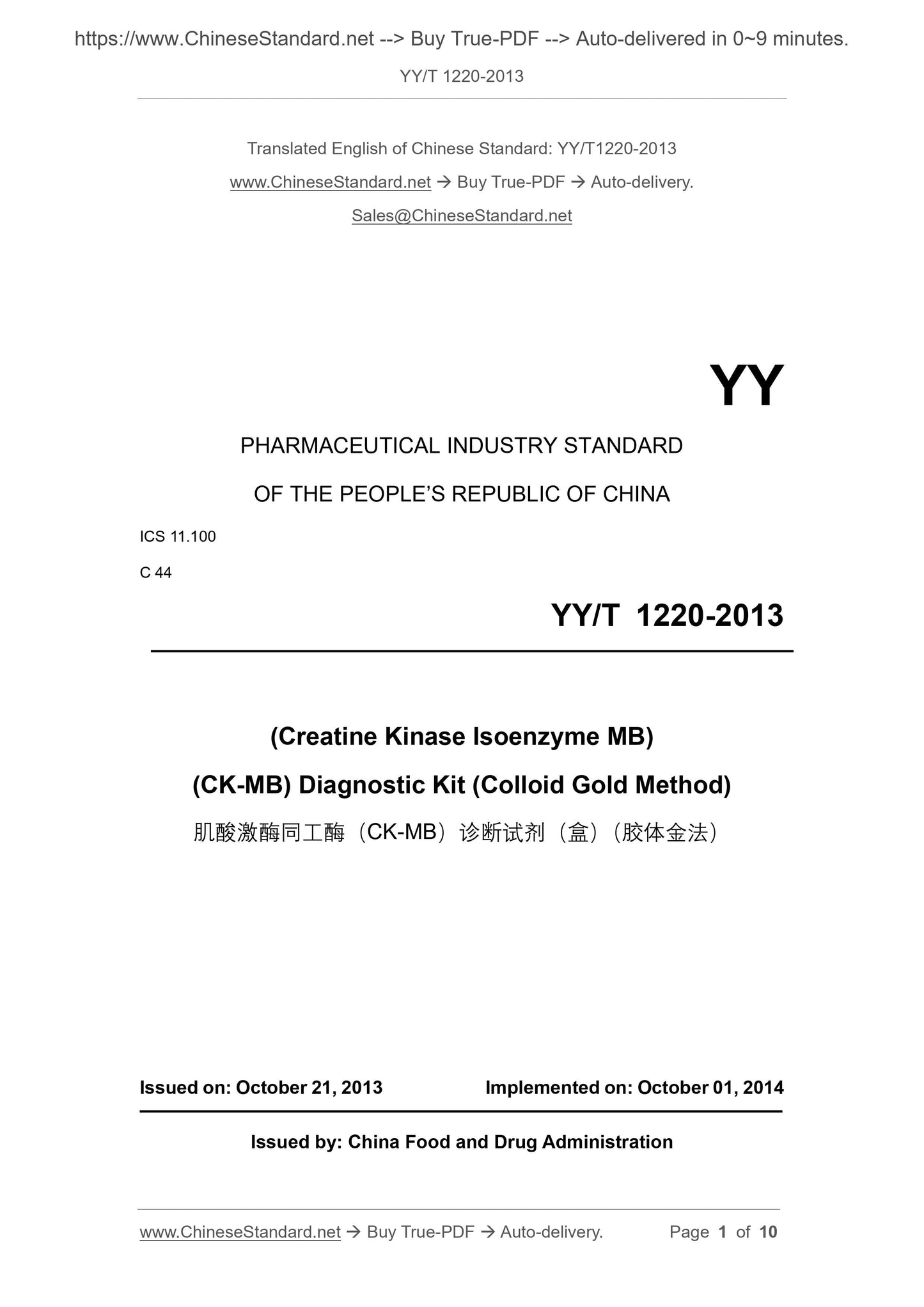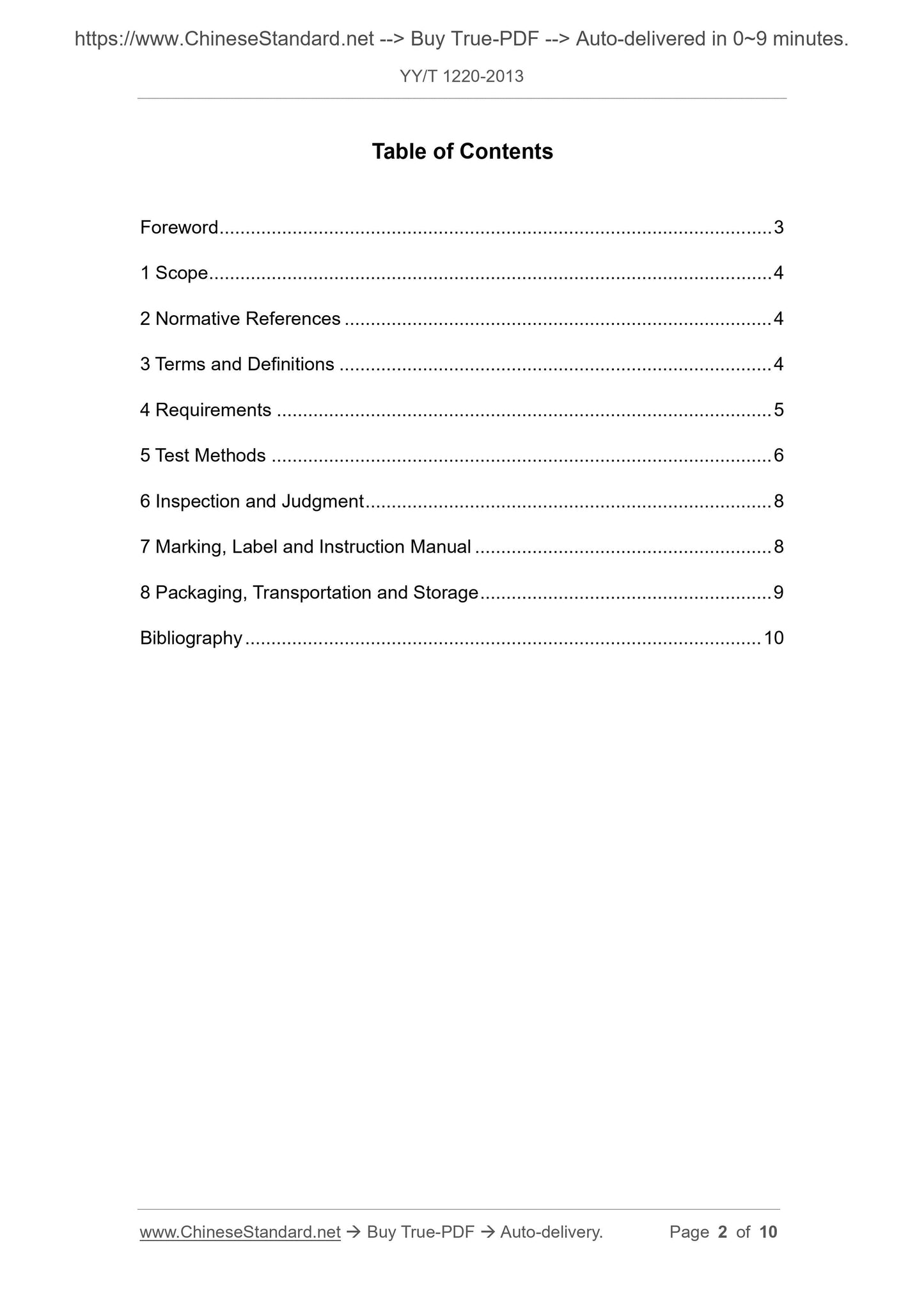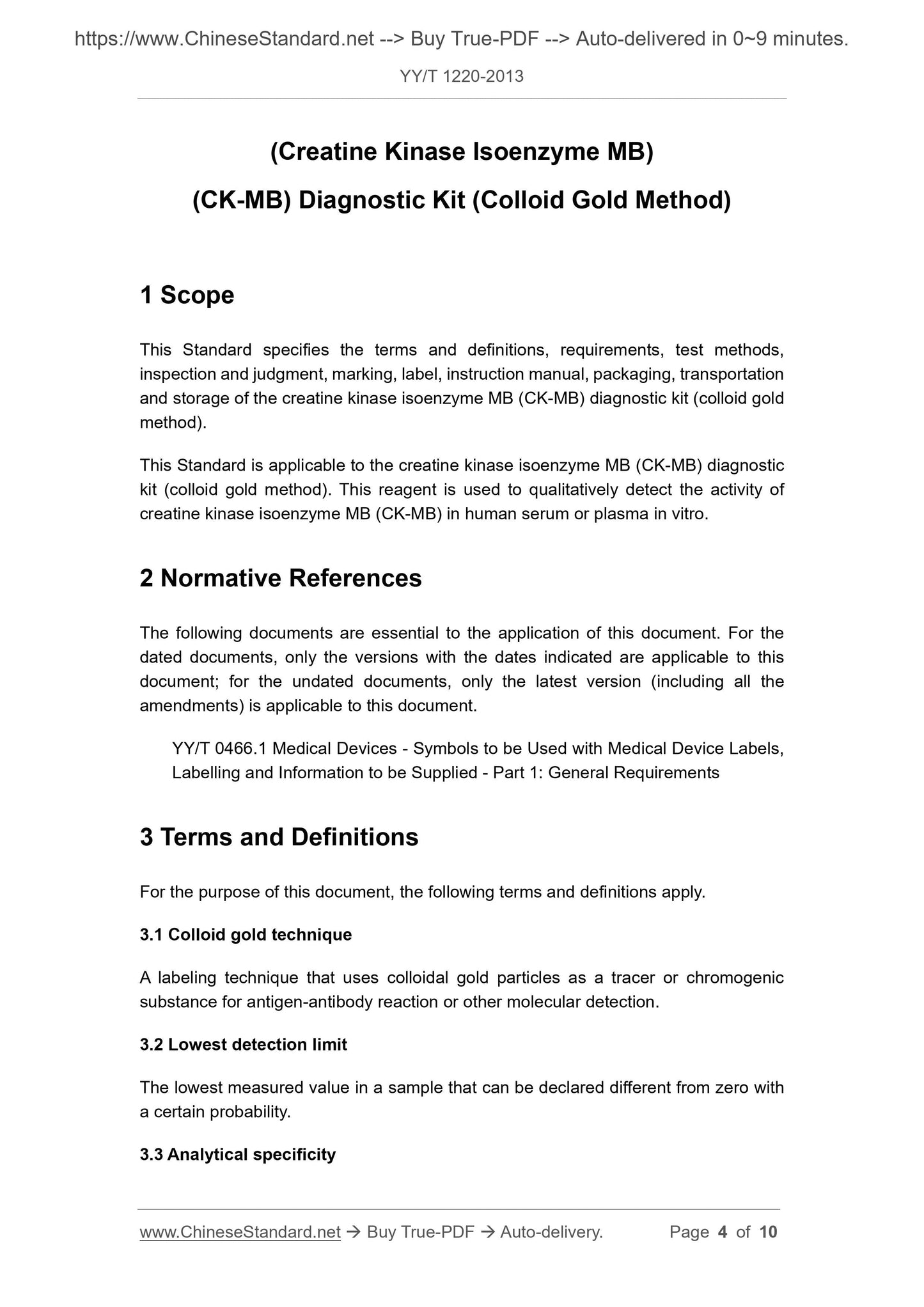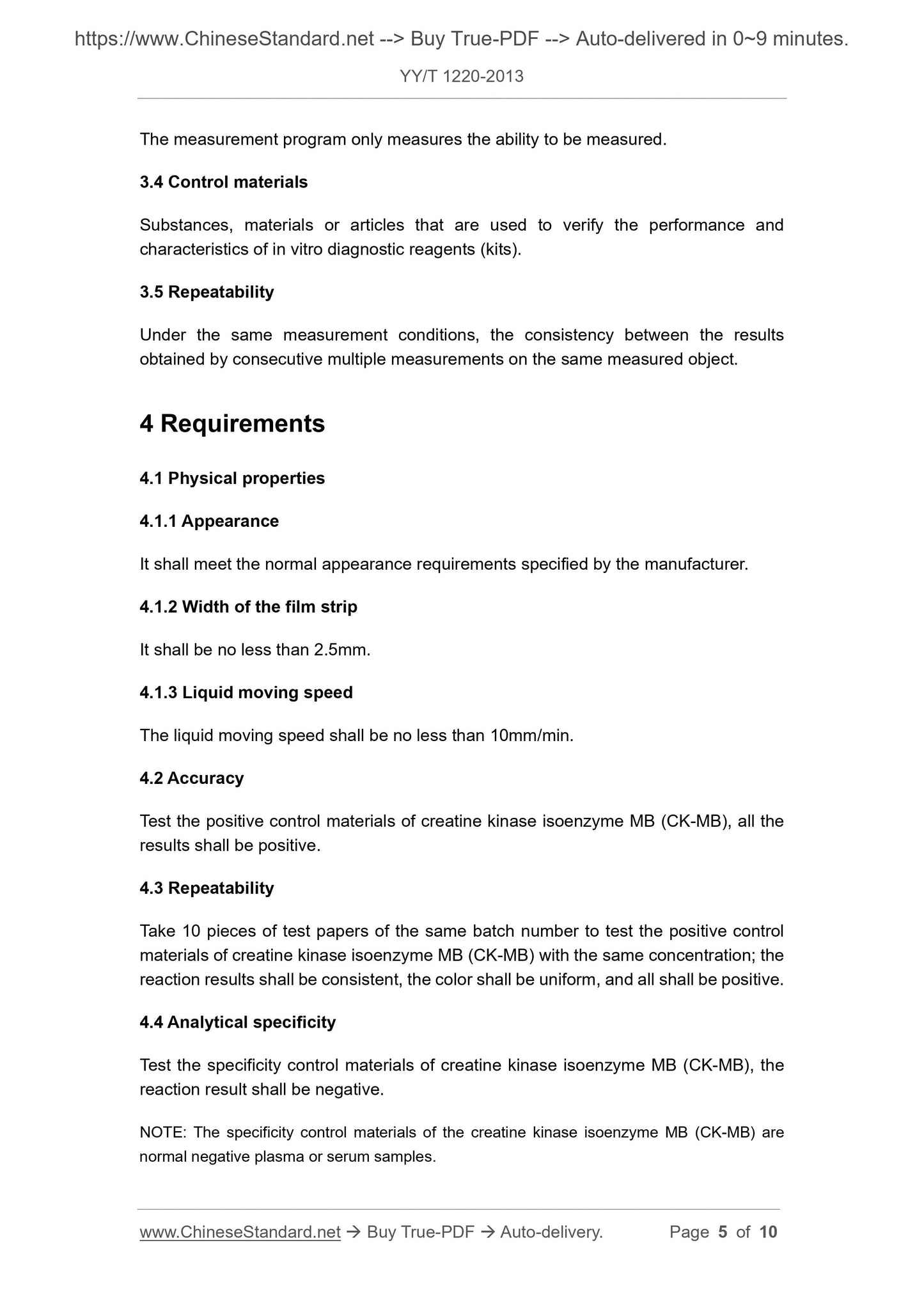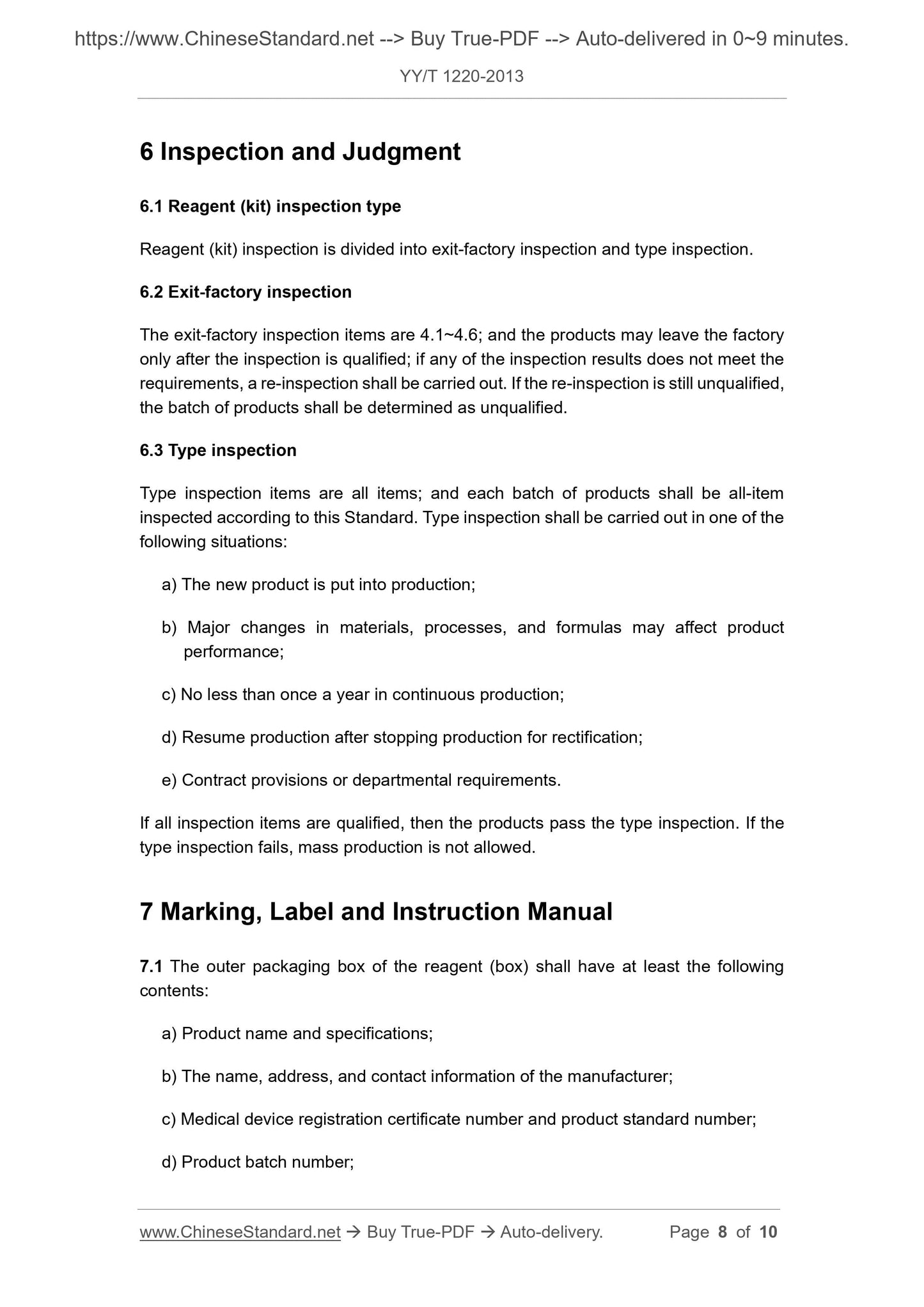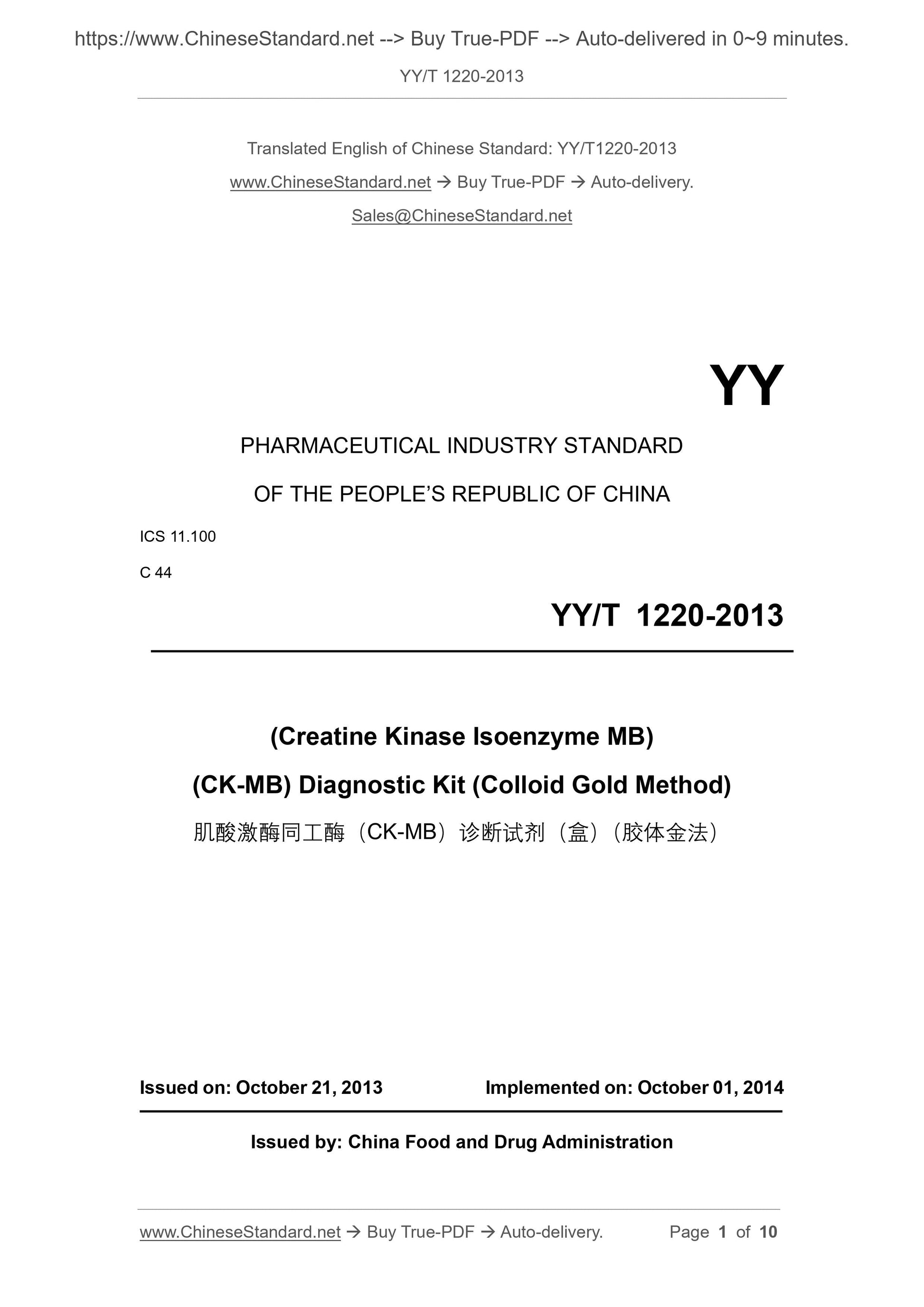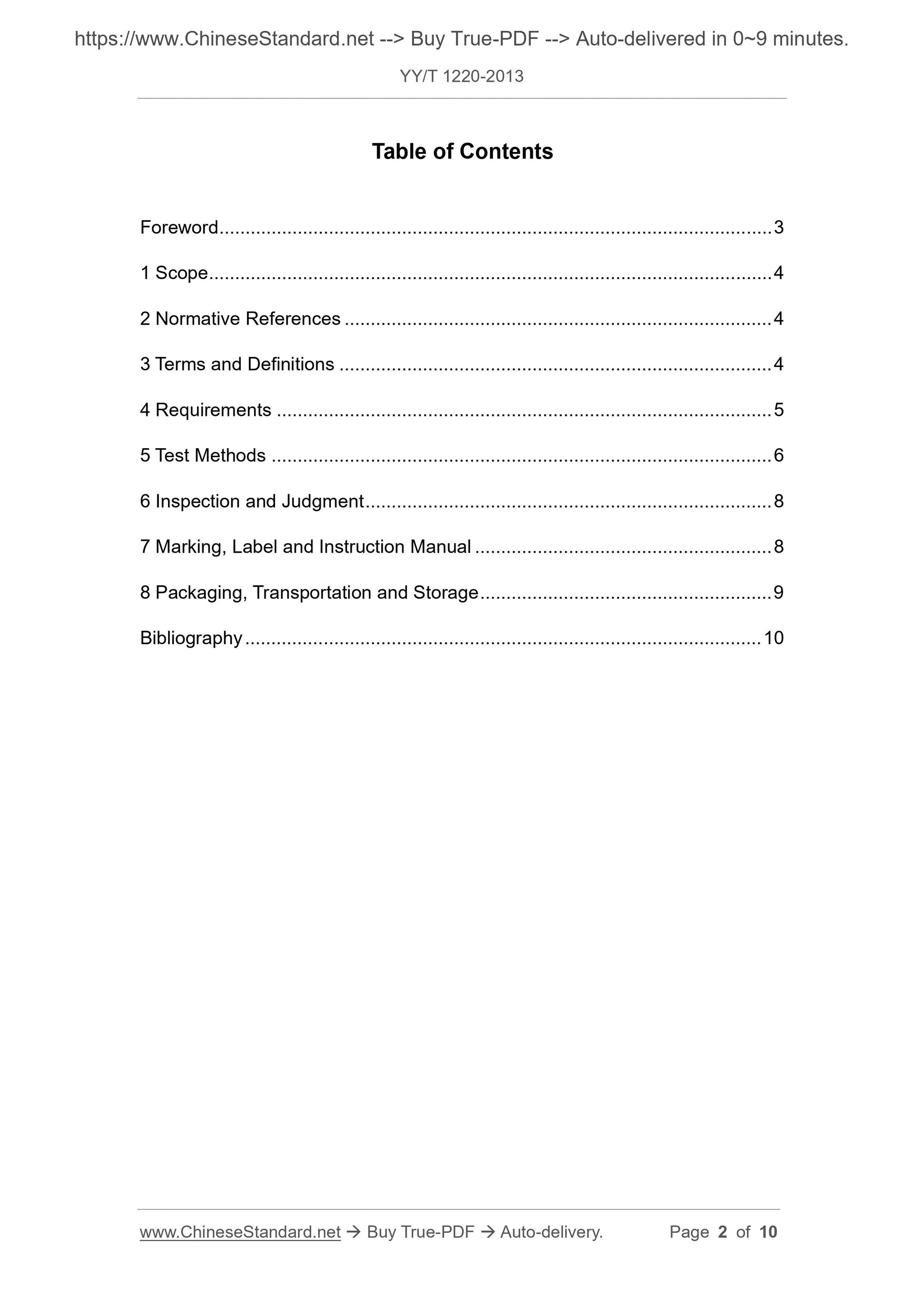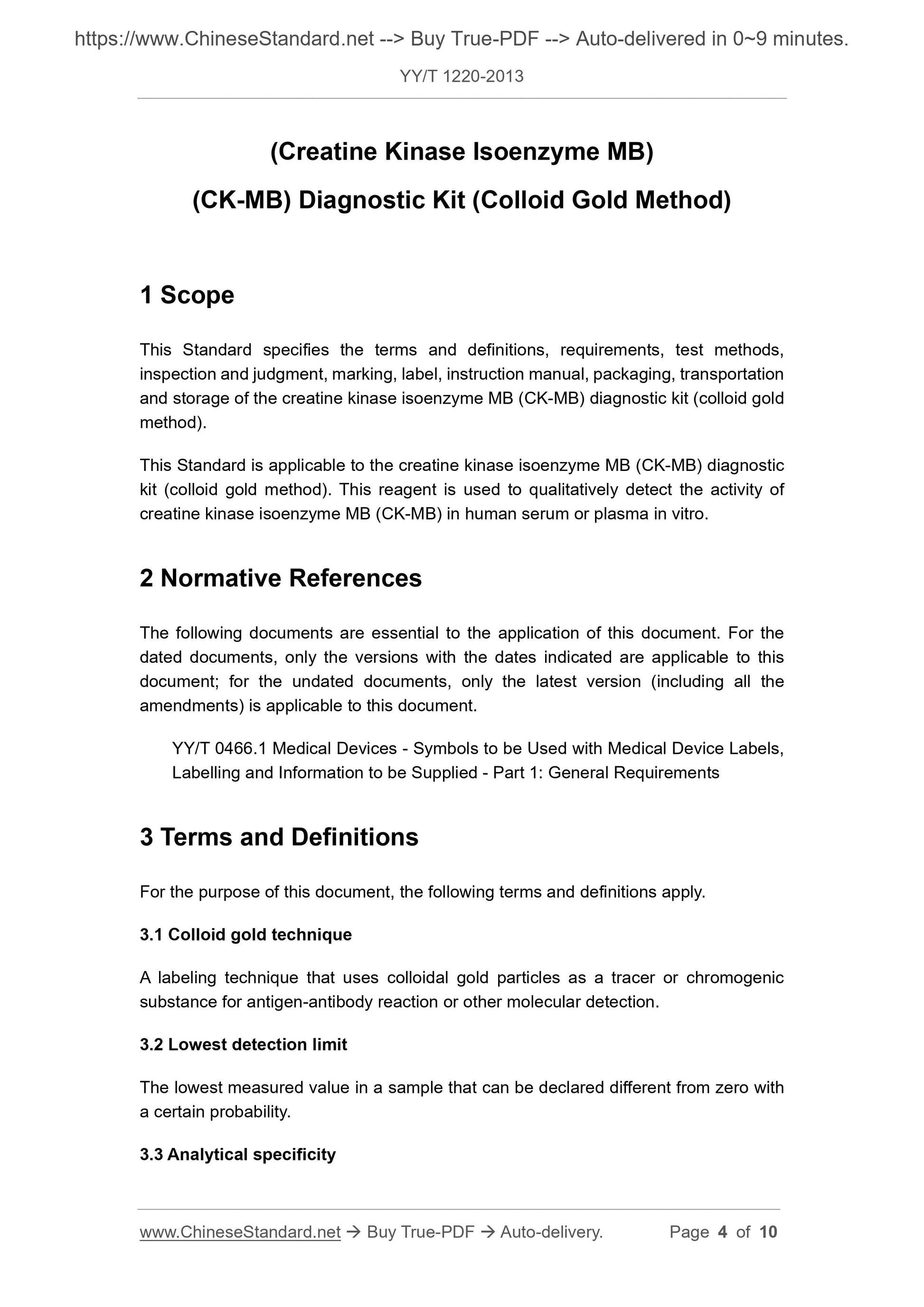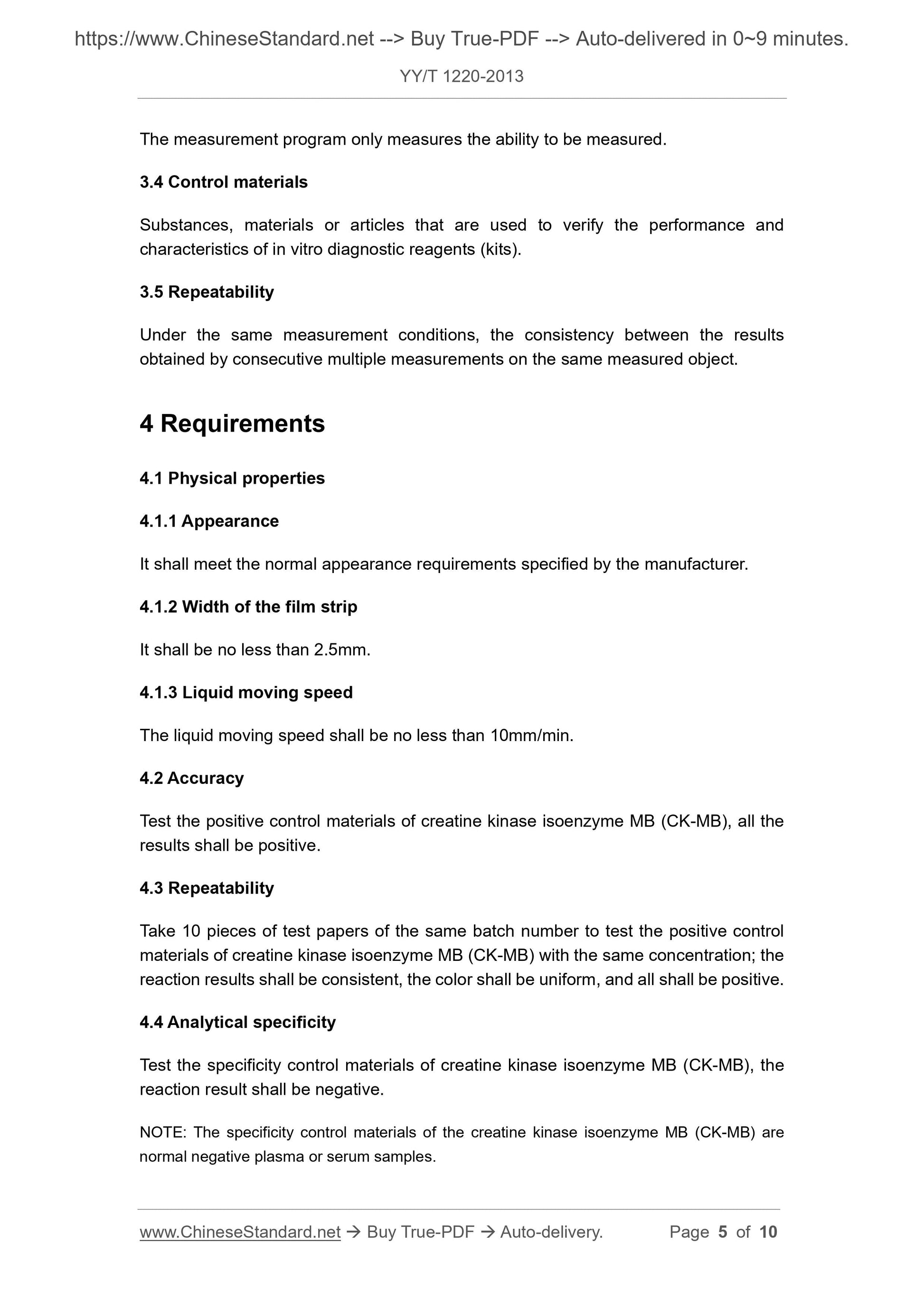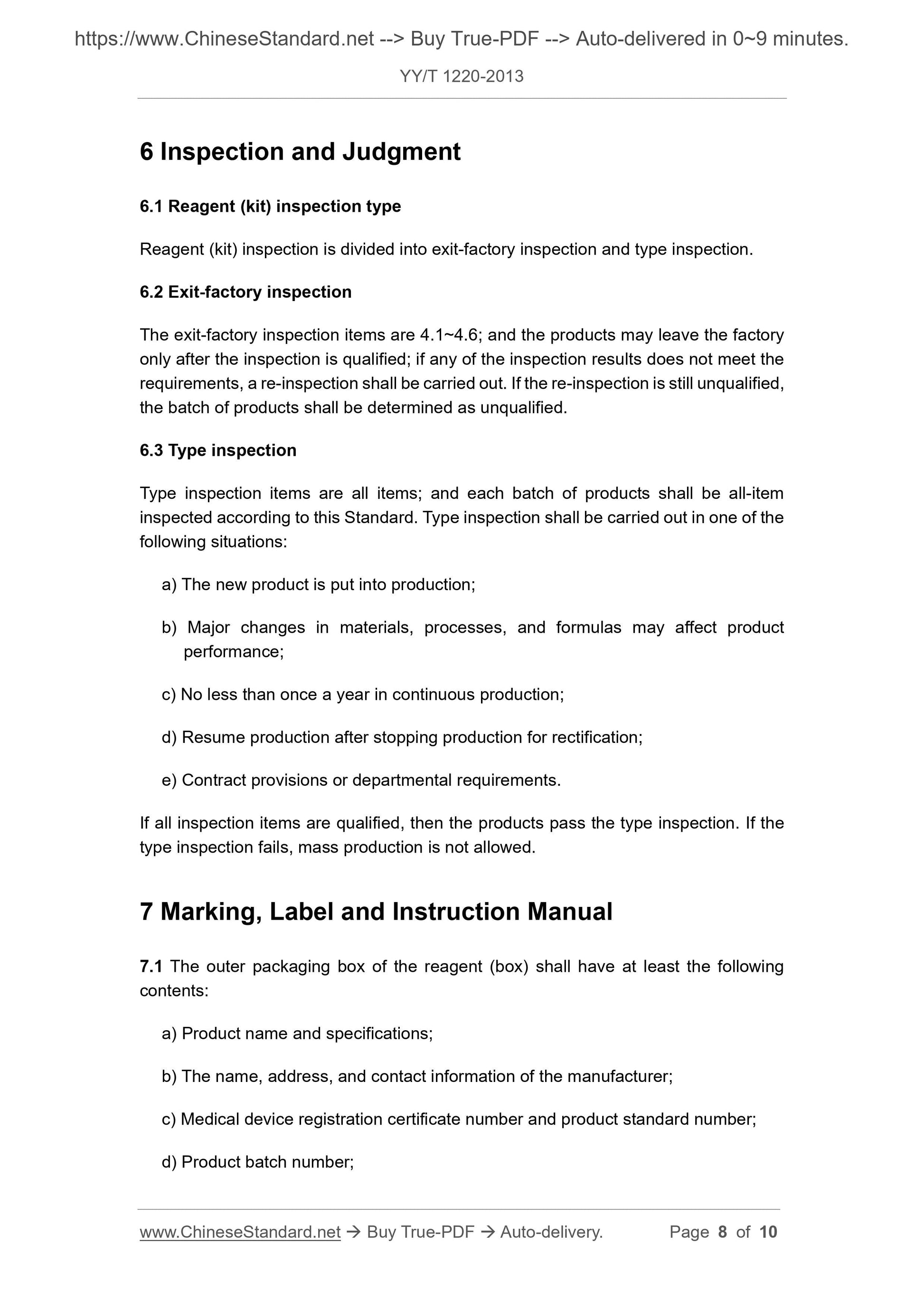1
/
of
5
PayPal, credit cards. Download editable-PDF & invoice in 1 second!
YY/T 1220-2013 English PDF (YYT1220-2013)
YY/T 1220-2013 English PDF (YYT1220-2013)
Regular price
$150.00 USD
Regular price
Sale price
$150.00 USD
Unit price
/
per
Shipping calculated at checkout.
Couldn't load pickup availability
Delivery: 3 seconds. Download true-PDF + Invoice.
Get QUOTATION in 1-minute: Click YY/T 1220-2013
Historical versions: YY/T 1220-2013
Preview True-PDF (Reload/Scroll if blank)
YY/T 1220-2013: Creatine kinase isoenzyme MB (CK-MB) diagnostic kit (Colloid gold method)
YY/T 1220-2013
YY
PHARMACEUTICAL INDUSTRY STANDARD
OF THE PEOPLE’S REPUBLIC OF CHINA
ICS 11.100
C 44
(Creatine Kinase Isoenzyme MB)
(CK-MB) Diagnostic Kit (Colloid Gold Method)
ISSUED ON: OCTOBER 21, 2013
IMPLEMENTED ON: OCTOBER 01, 2014
Issued by: China Food and Drug Administration
Table of Contents
Foreword ... 3
1 Scope ... 4
2 Normative References ... 4
3 Terms and Definitions ... 4
4 Requirements ... 5
5 Test Methods ... 6
6 Inspection and Judgment ... 8
7 Marking, Label and Instruction Manual ... 8
8 Packaging, Transportation and Storage ... 9
Bibliography ... 10
(Creatine Kinase Isoenzyme MB)
(CK-MB) Diagnostic Kit (Colloid Gold Method)
1 Scope
This Standard specifies the terms and definitions, requirements, test methods,
inspection and judgment, marking, label, instruction manual, packaging, transportation
and storage of the creatine kinase isoenzyme MB (CK-MB) diagnostic kit (colloid gold
method).
This Standard is applicable to the creatine kinase isoenzyme MB (CK-MB) diagnostic
kit (colloid gold method). This reagent is used to qualitatively detect the activity of
creatine kinase isoenzyme MB (CK-MB) in human serum or plasma in vitro.
2 Normative References
The following documents are essential to the application of this document. For the
dated documents, only the versions with the dates indicated are applicable to this
document; for the undated documents, only the latest version (including all the
amendments) is applicable to this document.
YY/T 0466.1 Medical Devices - Symbols to be Used with Medical Device Labels,
Labelling and Information to be Supplied - Part 1: General Requirements
3 Terms and Definitions
For the purpose of this document, the following terms and definitions apply.
3.1 Colloid gold technique
A labeling technique that uses colloidal gold particles as a tracer or chromogenic
substance for antigen-antibody reaction or other molecular detection.
3.2 Lowest detection limit
The lowest measured value in a sample that can be declared different from zero with
a certain probability.
3.3 Analytical specificity
The measurement program only measures the ability to be measured.
3.4 Control materials
Substances, materials or articles that are used to verify the performance and
characteristics of in vitro diagnostic reagents (kits).
3.5 Repeatability
Under the same measurement conditions, the consistency between the results
obtained by consecutive multiple measurements on the same measured object.
4 Requirements
4.1 Physical properties
4.1.1 Appearance
It shall meet the normal appearance requirements specified by the manufacturer.
4.1.2 Width of the film strip
It shall be no less than 2.5mm.
4.1.3 Liquid moving speed
The liquid moving speed shall be no less than 10mm/min.
4.2 Accuracy
Test the positive control materials of creatine kinase isoenzyme MB (CK-MB), all the
results shall be positive.
4.3 Repeatability
Take 10 pieces of test papers of the same batch number to test the positive control
materials of creatine kinase isoenzyme MB (CK-MB) with the same concentration; the
reaction results shall be consistent, the color shall be uniform, and all shall be positive.
4.4 Analytical specificity
Test the specificity control materials of creatine kinase isoenzyme MB (CK-MB), the
reaction result shall be negative.
NOTE: The specificity control materials of the creatine kinase isoenzyme MB (CK-MB) are
normal negative plasma or serum samples.
6 Inspection and Judgment
6.1 Reagent (kit) inspection type
Reagent (kit) inspection is divided into exit-factory inspection and type inspection.
6.2 Exit-factory inspection
The exit-factory inspection items are 4.1~4.6; and the products may leave the factory
only after the inspection is qualified; if any of the inspection results does not meet the
requirements, a re-inspection shall be carried out. If the re-inspection is still unqualified,
the batch of products shall be determined as unqualified.
6.3 Type inspection
Type inspection items are all items; and each batch of products shall be all-item
inspected according to this Standard. Type inspection shall be carried out in one of the
following situations:
a) The new product is put into production;
b) Major changes in materials, processes, and formulas may affect product
performance;
c) No less than once a year in continuous production;
d) Resume production after stopping production for rectification;
e) Contract provisions or departmental requirements.
If all inspection items are qualified, then the products pass the type inspection. If the
type inspection fails, mass production is not allowed.
7 Marking, Label and Instruction Manual
7.1 The outer packaging box of the reagent (box) shall have at least the following
contents:
a) Product name and specifications;
b) The name, address, and contact information of the manufacturer;
c) Medical device registration certificate number and product standard number;
d) Product batch number;
Get QUOTATION in 1-minute: Click YY/T 1220-2013
Historical versions: YY/T 1220-2013
Preview True-PDF (Reload/Scroll if blank)
YY/T 1220-2013: Creatine kinase isoenzyme MB (CK-MB) diagnostic kit (Colloid gold method)
YY/T 1220-2013
YY
PHARMACEUTICAL INDUSTRY STANDARD
OF THE PEOPLE’S REPUBLIC OF CHINA
ICS 11.100
C 44
(Creatine Kinase Isoenzyme MB)
(CK-MB) Diagnostic Kit (Colloid Gold Method)
ISSUED ON: OCTOBER 21, 2013
IMPLEMENTED ON: OCTOBER 01, 2014
Issued by: China Food and Drug Administration
Table of Contents
Foreword ... 3
1 Scope ... 4
2 Normative References ... 4
3 Terms and Definitions ... 4
4 Requirements ... 5
5 Test Methods ... 6
6 Inspection and Judgment ... 8
7 Marking, Label and Instruction Manual ... 8
8 Packaging, Transportation and Storage ... 9
Bibliography ... 10
(Creatine Kinase Isoenzyme MB)
(CK-MB) Diagnostic Kit (Colloid Gold Method)
1 Scope
This Standard specifies the terms and definitions, requirements, test methods,
inspection and judgment, marking, label, instruction manual, packaging, transportation
and storage of the creatine kinase isoenzyme MB (CK-MB) diagnostic kit (colloid gold
method).
This Standard is applicable to the creatine kinase isoenzyme MB (CK-MB) diagnostic
kit (colloid gold method). This reagent is used to qualitatively detect the activity of
creatine kinase isoenzyme MB (CK-MB) in human serum or plasma in vitro.
2 Normative References
The following documents are essential to the application of this document. For the
dated documents, only the versions with the dates indicated are applicable to this
document; for the undated documents, only the latest version (including all the
amendments) is applicable to this document.
YY/T 0466.1 Medical Devices - Symbols to be Used with Medical Device Labels,
Labelling and Information to be Supplied - Part 1: General Requirements
3 Terms and Definitions
For the purpose of this document, the following terms and definitions apply.
3.1 Colloid gold technique
A labeling technique that uses colloidal gold particles as a tracer or chromogenic
substance for antigen-antibody reaction or other molecular detection.
3.2 Lowest detection limit
The lowest measured value in a sample that can be declared different from zero with
a certain probability.
3.3 Analytical specificity
The measurement program only measures the ability to be measured.
3.4 Control materials
Substances, materials or articles that are used to verify the performance and
characteristics of in vitro diagnostic reagents (kits).
3.5 Repeatability
Under the same measurement conditions, the consistency between the results
obtained by consecutive multiple measurements on the same measured object.
4 Requirements
4.1 Physical properties
4.1.1 Appearance
It shall meet the normal appearance requirements specified by the manufacturer.
4.1.2 Width of the film strip
It shall be no less than 2.5mm.
4.1.3 Liquid moving speed
The liquid moving speed shall be no less than 10mm/min.
4.2 Accuracy
Test the positive control materials of creatine kinase isoenzyme MB (CK-MB), all the
results shall be positive.
4.3 Repeatability
Take 10 pieces of test papers of the same batch number to test the positive control
materials of creatine kinase isoenzyme MB (CK-MB) with the same concentration; the
reaction results shall be consistent, the color shall be uniform, and all shall be positive.
4.4 Analytical specificity
Test the specificity control materials of creatine kinase isoenzyme MB (CK-MB), the
reaction result shall be negative.
NOTE: The specificity control materials of the creatine kinase isoenzyme MB (CK-MB) are
normal negative plasma or serum samples.
6 Inspection and Judgment
6.1 Reagent (kit) inspection type
Reagent (kit) inspection is divided into exit-factory inspection and type inspection.
6.2 Exit-factory inspection
The exit-factory inspection items are 4.1~4.6; and the products may leave the factory
only after the inspection is qualified; if any of the inspection results does not meet the
requirements, a re-inspection shall be carried out. If the re-inspection is still unqualified,
the batch of products shall be determined as unqualified.
6.3 Type inspection
Type inspection items are all items; and each batch of products shall be all-item
inspected according to this Standard. Type inspection shall be carried out in one of the
following situations:
a) The new product is put into production;
b) Major changes in materials, processes, and formulas may affect product
performance;
c) No less than once a year in continuous production;
d) Resume production after stopping production for rectification;
e) Contract provisions or departmental requirements.
If all inspection items are qualified, then the products pass the type inspection. If the
type inspection fails, mass production is not allowed.
7 Marking, Label and Instruction Manual
7.1 The outer packaging box of the reagent (box) shall have at least the following
contents:
a) Product name and specifications;
b) The name, address, and contact information of the manufacturer;
c) Medical device registration certificate number and product standard number;
d) Product batch number;
Share
